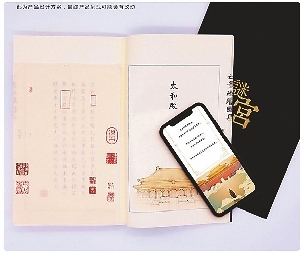

AN interactive puzzle-solving game book, “Migong: Ruyi Linlang Tuji” (“Mystery Palace: Map of Treasures in the Palace”), which looks deeper at the life of Emperor Qianlong of the Qing Dynasty (1644-1911), will be published by the publishing house of the Palace Museum. Legend has it that a book by the name of “Ruyi Linlang Tuji” by a palace artist was discovered in the Forbidden City in 1766, the 31st year during Qianlong’s reign. The book was so difficult to decipher that it was deemed “useless” and then it disappeared. Later, rumors started spreading that “Ruyi Linlang Tuji” actually contained the location of treasures inside the Forbidden City, treasures so rich to change the course of one’s life. Zhou Ben, who was a nameless artist in the palace, one day inadvertently discovered the book among a pile of papers. Having heard the rumor, Zhou made up his mind to find the treasures, not knowing the obstacles he would face and the intricate palatial battle he would entangle himself in during the process. More than two centuries later, the Palace Museum is now giving readers a chance to be Zhou Ben across time and space through the release of “Migong: Ruyi Linlang Tuji.” Readers can now flip through the pages of a labyrinth of perplexities, decode hints and discover the whereabouts of hidden treasures. A creative innovation Xu Aolin, who designed the games in “Migong: Ruyi Linlang Tuji,” said he clearly remembers where the project unfolded. “We were walking around and came across a painting. Wang Zhiwei from the publishing house then introduced it to us.” The painting was “Eightieth Longevity Picture of Empress Dowager Chongqing” painted during the 36th year of reign of Qianlong in celebration of the 80th birthday of Empress Dowager Chongqing. “We then thought whether we could create a game plot based on this painting,” Xu added. He later discovered Zhou Ben, who was one of the three painters that worked on the painting, and set the framework of the story. There are little historical records on Zhou, which conveniently gave enough space for imagination during the process of creation. There are more than 30 interlocking missions in the game, and many are closely related to this painting. “The protagonist in the game needs to complete this painting. To do so, you need to understand the court allusions and rules. This gives people living today a channel for getting to know the Forbidden City better,” said Wang Zhiwei, one of the authors and historical editorial director at the publishing house. One innovative feature of “Migong” is the unique decoding experience from reading the book and participating in online games. Readers can flip through pages while playing the part of the protagonist more realistically through their smart phones. Other props that help the readers get into the scene include a copper coin, which mimics those actually used during the Qing Dynasty, transparent sheets of paper that overlap certain pages to reveal more hints, and much more. “There are many historical details hidden in the book. We will not say where, and hopefully readers can discover them themselves with close attention,” added Wang. “We used a lot of traditional Chinese elements in the design,” said Xu, “including palatial paintings, architecture, history, theatrical art and even chess scores, so as to provide more ways to understand history while playing the game.” Young creators It is noteworthy that the core design team of the project is quite young. Xu Aolin and Chen Zhendu, who respectively worked on the design and plot, were both born in 1988. Li Huiting, born in the ’90s, worked on the game route. Wang, 34, the only person from the Palace Museum and who worked as the advisor of historical facts, is the most senior member of the team. The Palace Museum has carried forward many innovative cultural projects in recent years in hopes of triggering more interest in the younger generation in the Forbidden City. The range of products includes cultural products such as fans, notebooks, downloadable apps for children, GIFs and beautifully-designed calendars. The team is now working on the portable ends of the project. A second edition of the book is also being planned. When asked what message he wanted to convey to the readers, Wang pointed to an old photograph on the wall of his office. “This is the first picture ever taken of the Forbidden City. There were none before it. The picture may look monochrome to you, but in my eyes, it’s vibrant in color. “What I want the readers, or players, of the book to feel is that ‘decorous history can also be lively.’ I hope that traditional culture can be spread and passed on in a completely novel way,” Wang responded. The interactive game book is the first project of its kind attempted by the Palace Museum. The publishing house originally aimed to gather 100,000 yuan (US$14,418) through crowd funding, which it did with ease as the figure surpassed 1 million yuan in just 10 hours. It broke the record in crowd funding in the Chinese publishing industry in 24 hours. Now the figure stands at 10 million yuan in 26 days. “Migong” is scheduled to go on pre-sale at the Palace Museum flagship stores both offline and online in December. Hard copies are scheduled to go on shelves in January 2019. (China Daily) | 
